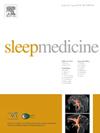过渡到轮班工作期间的适应性睡眠行为和轮班工作耐受性。
IF 3.8
2区 医学
Q1 CLINICAL NEUROLOGY
引用次数: 0
摘要
目的评估新招聘的护理人员在轮班工作的头 12 个月中是否会调整自己的睡眠行为,并找出轮班工作 12 个月后与更好的轮班工作耐受性(SWT)相关的睡眠行为:在轮班工作前(基线)以及轮班工作 6 个月和 12 个月后,对招聘的护理人员(n = 105;年龄 = 25.81 岁;51.38% 为女性)进行了评估。在每个时间点,参与者都填写了心理健康和睡眠评估问卷。在每个时间点,参与者还接受了为期 14 天的睡眠和轮班监测(睡眠/工作日记和动态心电图),以检查睡眠行为,包括睡眠机会(SO)、睡眠规律性和睡眠次数:线性混合模型发现,在基线和随访时间点之间,睡眠机会增加(白班和休息日),睡眠规律性降低。轮班工作 6 个月至 12 个月期间,SO(白班、夜班和休息日)和睡眠规律性均无变化。在 12 个月的随访中,通过潜在特征分析发现,护理人员的 SWT 水平分别为高(52 人)、中(27 人)和低(9 人)(通过抑郁、焦虑、失眠、睡眠质量和睡眠效率进行测量)。工作 6 个月至 12 个月期间睡眠规律性降低(即睡眠更不规律),以及工作 6 个月后优先考虑主要睡眠(而不是小睡),都预示着 SWT 水平较高:这些研究结果表明,在护理人员职业生涯的早期就存在明显的SWT水平,其中抑郁、焦虑和失眠症状对SWT的影响最大。新护理人员的睡眠行为,包括睡眠规律性和在夜班之间优先延长睡眠时间,可能会在影响护理人员如何忍受轮班工作方面发挥重要作用。本文章由计算机程序翻译,如有差异,请以英文原文为准。
Adaptive sleep behaviours and shift work tolerance during the transition to shift work
Objective
To evaluate whether recruit paramedics adapt their sleep behaviour during the first 12-months of shift work and to identify sleep behaviours that are associated with better shift work tolerance (SWT) after 12-months of shift work.
Methods
Recruit paramedics (n = 105; Mage = 25.81 years; 51.38% female) were evaluated before (baseline), and after six- and 12-months of shift work. At each timepoint, participants completed questionnaires evaluating their mental health and sleep. Participants also underwent 14 days of sleep and shift monitoring (sleep/work diaries and actigraphy) at each timepoint to examine sleep behaviours, including sleep opportunity (SO), sleep regularity and number of sleep episodes.
Results
Linear mixed models found SO increased (on day shifts and rest days), and sleep regularity decreased between baseline and follow-up timepoints. There were no changes in SO (on day shifts, nightshifts, and rest days) or sleep regularity between six- and 12-months of shift work. Latent profile analysis at 12-months follow-up identified high (n = 52), medium (n = 27), and low (n = 9) SWT levels (measured via depression, anxiety, insomnia, sleep quality and sleep efficiency) in paramedics. Reduced sleep regularity (i.e., more irregular sleep) between six- and 12-months of work and prioritising major sleep (rather than naps) at six-months predicted high SWT.
Conclusions
These findings suggest clear SWT levels exist early in paramedics' careers whereby symptoms of depression, anxiety, and insomnia were the strongest contributors to SWT. New paramedics’ sleep behaviours, including sleep regularity and prioritisation of longer sleep between nightshifts, may play an important role in influencing how paramedics tolerate shift work.
求助全文
通过发布文献求助,成功后即可免费获取论文全文。
去求助
来源期刊

Sleep medicine
医学-临床神经学
CiteScore
8.40
自引率
6.20%
发文量
1060
审稿时长
49 days
期刊介绍:
Sleep Medicine aims to be a journal no one involved in clinical sleep medicine can do without.
A journal primarily focussing on the human aspects of sleep, integrating the various disciplines that are involved in sleep medicine: neurology, clinical neurophysiology, internal medicine (particularly pulmonology and cardiology), psychology, psychiatry, sleep technology, pediatrics, neurosurgery, otorhinolaryngology, and dentistry.
The journal publishes the following types of articles: Reviews (also intended as a way to bridge the gap between basic sleep research and clinical relevance); Original Research Articles; Full-length articles; Brief communications; Controversies; Case reports; Letters to the Editor; Journal search and commentaries; Book reviews; Meeting announcements; Listing of relevant organisations plus web sites.
 求助内容:
求助内容: 应助结果提醒方式:
应助结果提醒方式:


